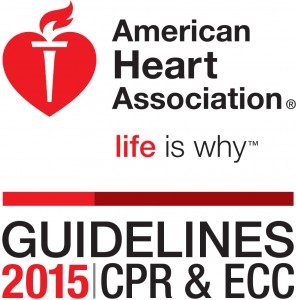Since first establishing guidelines in 1966, the American Heart Association has led evaluation and dissemination of the latest resuscitation science to help inform and modernize the lifesaving practice of CPR. The AHA guidelines, updated every 5 years, are used to train millions of potential rescuers and are integrated into state and local emergency medical services protocols. Recently, the AHA released its 2015 Guidelines Update for Cardiopulmonary Resuscitation (CPR) and Emergency Cardiovascular Care (ECC).
The latest American Heart Association guidelines highlight how quick action, proper training, use of technology and coordinated efforts can increase survival from cardiac arrest. People should continue to jump in quickly to give CPR, using breaths if they’ve been trained in CPR and employing mobile technology to speed up the rescue of cardiac arrest victims.
A leading cause of death in the United States, cardiac arrest is caused when the heart suddenly stops, usually due to an electrical malfunction in the heart that causes an irregular heartbeat and disrupts blood flow through the body. Survival depends on immediate CPR and other actions starting with bystanders.
More than 326,000 people experience cardiac arrest outside of a hospital each year and about 90 percent of them die, often because bystanders don’t know how to start CPR or are afraid they’ll do something wrong. The 2015 guidelines say CPR training will help bystanders feel more confident to act and to provide better CPR with the ultimate goal of having immediate CPR given to all victims of cardiac arrest. Effective bystander CPR, provided immediately after cardiac arrest, can double or triple a victim’s chance of survival.
Everyone has a role to play in the chain of survival – from bystanders to dispatchers, emergency responders to healthcare providers. When everyone knows their role, knows CPR and works together, we can dramatically improve cardiac arrest victims’ chances of survival.
The AHA guidelines, which are based off the latest resuscitation research, have been published since 1966 to provide science-based recommendations for treating cardiovascular emergencies – particularly cardiac arrest in adults, children, infants and newborns. This 2015 update confirms known CPR recommendations with several quality enhancements to help save even more lives, including a range for the rate and depth of chest compressions during CPR. The last update to the guidelines was in 2010.
Key points from the 2015 Guidelines Update provides bystanders, dispatchers and communities with practical guidance to improve the effectiveness of their teamwork:
- Untrained bystanders should call 911 and provide Hands-Only CPR, or CPR without breaths, pushing hard and fast in the center of the chest to the rate of 100-120 compressions per minute. If the bystander is trained in CPR and can perform breaths, he or she should add breaths in a 30:2 compressions-to-breaths ratio.
- Bystanders should use mobile phones to immediately call 911, placing the phones on speaker, so the dispatcher can help bystanders check for breathing, get the precise location and provide instructions for performing CPR.
- Dispatchers should be trained to help bystanders check for breathing and recognize cardiac arrest. Dispatchers should also be aware that brief generalized seizures may be an early sign of cardiac arrest.
- Mobile dispatch systems that notify potential rescuers of a nearby presumed cardiac arrest can improve the rate of bystander CPR and shorten the time to first chest compressions. Communities may want to consider this service to improve the chain of survival.
Additional resources:
Comparison Chart 2015 AHA Guidelines for CPR and ECC
Highlights of the 2015 AHA Guidelines Update for CPR & ECC
American Heart Association 2015 Guidelines for CPR & ECC Website
SOURCE: American Heart Association


